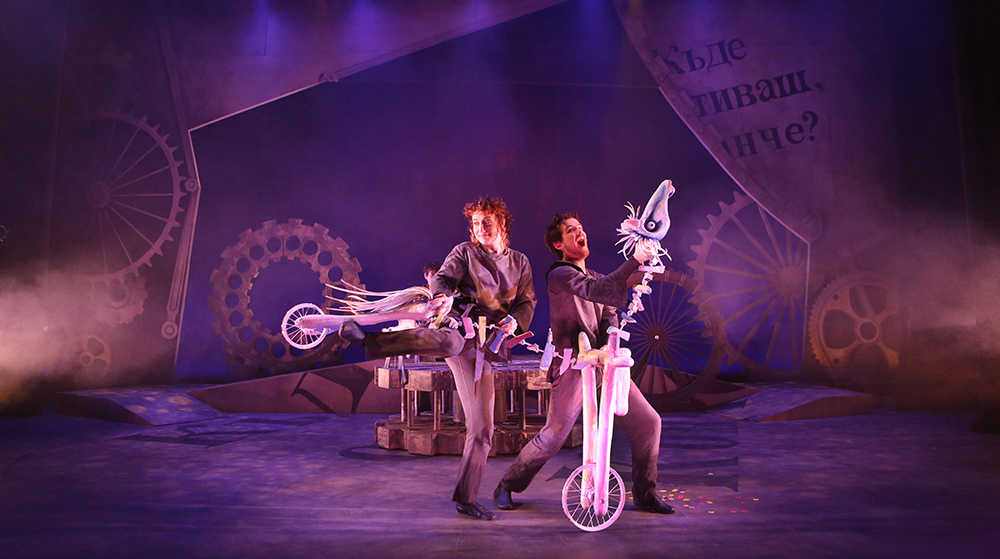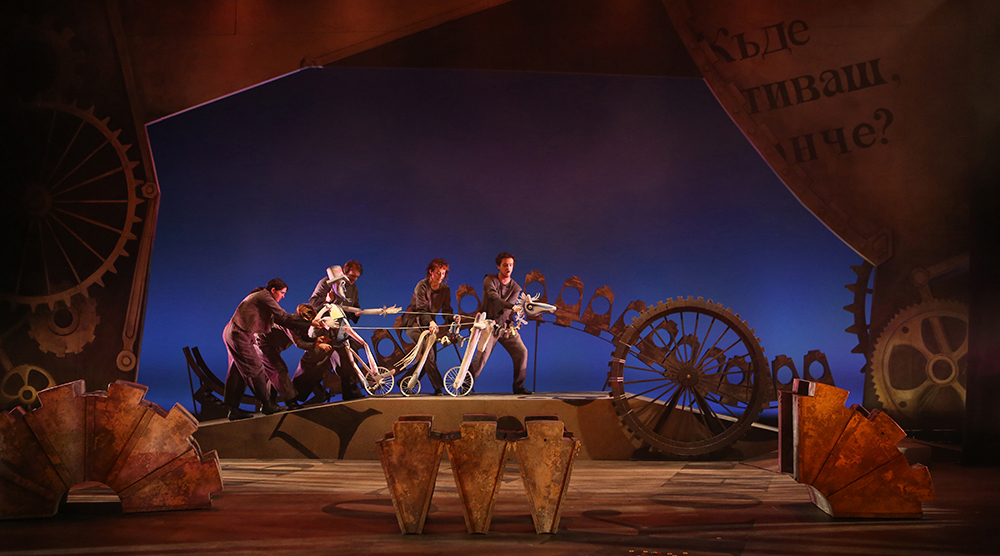BY MAX MCGUIRE ’24

About two weeks ago, the Skidmore Theater Department successfully closed its run of the Mainstage production Where Are You Going, Little Horse?, written by Bulgarian playwright Rada Moskova and directed by Visiting Assistant Professor in Directing Margarita Blush. Over the course of one semester, Blush and her creative team produced a sixty-minute-long translation of a play that was originally just under twenty pages long, leaving audience members with both a sense of childlike whimsy and a curiosity reminiscent of the works of Tim Burton.
The show follows the Little Boy (voiced and puppeteered by Jordan Azzinaro ‘26, with puppeteering by Isadora Zucker ‘25 and Sky Estrada ‘27) forced to work as a carnival busser for The Carnival Master (voiced and puppeteered by John Harrington ‘24, with puppeteering by Claire Butkin ‘27 and Finn Krol ‘27). The Little Boy has dreams of seeing the world beyond the carnival, repeatedly saying “But I want-” to both the audience and The Carnival Master. The Little Boy’s aspirations and longing parallel with the character of The Little Horse, (voiced and puppeteered by Sophie Kelly ‘25 with puppeteering by Maggie Krieg ‘26). The Little Horse aspires to be big and brave like the other horses in his herd, particularly The Big Horse (voiced by Lucas Falick ‘25 who also served as Assistant Director to the production). The Little Horse longs for the security of a roof over his head and cotton candy to eat, falling victim to The Carnival Master’s plans to add another horse to the carousel. Ultimately, the ingenuity and bravery of both The Little Horse and The Little Boy allow them to escape the world they’ve been trapped in, showing audience members that no matter how small one is, everyone can be big and brave.

I was impressed mostly by the puppets’ fluid movements, each of which was made of wood and yet still multi-articulated. The puppets were created by Connecticut artisan, comedian, and puppeteer Antony Sellitto-Budney with Sophie Kelly ‘25 as Assistant Puppet Builder. Sellito-Budney has worked in theater for almost a decade, involved in both puppetry and clowning works at the Mudlark Public Theater and the University of Connecticut, to name a few. Evidently, this was a perfect pairing of creatives to make the four puppets that drove the central narrative of the show. I would’ve been just as impressed if the entire show was only shadow-puppet work, which was used in the sequences with The Big Horse and the horse herd. However, Sellito-Budney and Kelly led a team of puppet builders, tasked with creating puppets that were fully painted, moved at every joint, moved on wheels, and mounted and dismounted a unicycle. During a Theater Company meeting, the cast described the process as ambitious, since their biggest challenge was learning how to act through the vessel of the puppet rather than their bodies.
A great example of this puppetry work would be The Carnival Horse, simultaneously the funniest character in the show, and also the most terrifying. Voiced by Max Weigel ‘24, with further puppeteering by Maddie Evans ‘24, the two actors created a signature movement where they would cross underneath one another to make their puppet pivot and swing. The Carnival Horse moved on a set of wheels and had a body with a rope like structure to convey the idea that somehow, The Carnival Master had created a being with horse-like qualities without actually making The Carnival Horse a “horse”. This was integral to the character’s arc considering that throughout the show, multiple characters tell The Carnival Horse that he is “not a real horse”. Of course, being that all he has ever known is how to be a carnival horse, he denies the characters’ assertions. Weigel played The Carnival Horse with a certain joviality, but the puppet itself had eyes that seemed to stare into the soul of anyone who glanced at it. But even the Carnival Horse learns what it means to be big and brave; in the end, he breaks away from The Carnival Master and learns that what he wants to be in life, the most, is a master of disguise.

Walking into the theater, the production team behind Where Are You Going, Little Horse brought the world of the carnival to life via the use of fairy lights that encroached upon the audience, projections, and costumes. Blush portrayed the cast as poetic bodies who emerge from a clockwork void, powered by the turning of visible cogs and wheels onstage. Sound designer Dylan Sallinger ’24 filled the theater with carnival music, thunder, and rusty cranks further enhanced this idea. The costumes, designed by Samantha Garwood, each had a unique silhouette despite being gray and covered in ink, with hand-printed gears on them to display a sense of inhuman unity. Finally, the wheels onstage were able to break apart and be reshaped during a four-minute long transition in which The Little Boy and The Little Horse go and explore the world outside the carnival. This transition was the peak moment of the show, both bringing the world of Where Are You Going, Little Horse? to life while also fully solidifying the idea that we are, in fact, watching an elaborate puppet show.
“I loved it! It was unlike anything I’ve ever seen before… I was smiling the entire time”, says Samantha Rochlin ‘26, an audience member who watched the show the same night as me. “It was amazing!” Nina Renkert ‘25, another audience member, exclaims. “Between the puppets and the set and the sound and the music- and you could just really tell that all of the ensemble worked beautifully together. I was so moved!” All in all, Where Are You Going, Little Horse? testifies to the collective aptitude of Skidmore Theater’s community. This project would simply not have been possible had the cast and crew not had incredible chemistry. Skidmore Theater is known for producing bizarre, experimental pieces, but for the first puppet show as a Mainstage I’ve seen during my four years here, I must say that Margarita Blush led this team with such grace. Bravo, as The Carnival Horse says, to the entire team behind this show!
Photos by Sue Kessler
***
Max McGuire ’24 is a staff writer for the Skidmore Theater Living Newsletter
